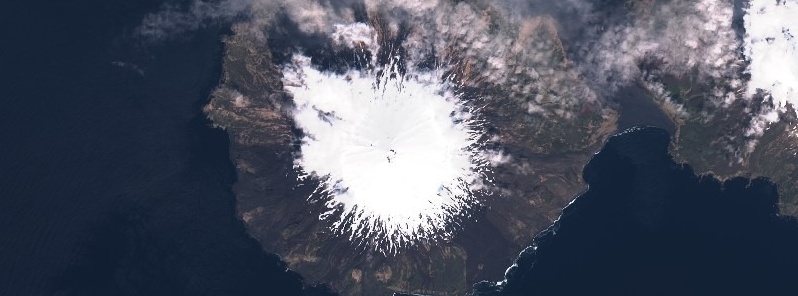Explosion at Cleveland volcano, Aviation Color Code raised to Orange, Alaska

A small explosion was detected at Cleveland volcano by regional infrasound sensors at about 06:32 UTC on June 2, 2020 (22:32 AKST, June 1). No other significant activity was detected and local monitoring stations are offline.
A small ash plume was observed at 6.7 km (22 000 feet) above sea level, drifting to the south.
The Aviation Color Code was raised from unassigned to Orange and the Volcano Alert Level from unassigned to Watch.
Explosions from Cleveland typically produce relatively small volcanic ash clouds that dissipate within hours; however, more significant ash emissions are possible.
Cleveland volcano is monitored with a limited real-time seismic network, which inhibits AVO’s ability to detect precursory unrest that may lead to an explosive eruption.
Rapid detection of an ash-producing eruption may be possible using a combination of seismic, infrasound, lightning, and satellite data.

Mount Cleveland on May 15, 2020. Credit: Copernicus EU/Sentinel-2, TW
Geological summary
Beautifully symmetrical Mount Cleveland stratovolcano is situated at the western end of the uninhabited, dumbbell-shaped Chuginadak Island. It lies SE across Carlisle Pass strait from Carlisle volcano and NE across Chuginadak Pass strait from Herbert volcano.
Cleveland is joined to the rest of Chuginadak Island by a low isthmus. The 1730-m-high (5 675 feet) Mount Cleveland is the highest of the Islands of the Four Mountains group and is one of the most active of the Aleutian Islands. The native name for Mount Cleveland, Chuginadak, refers to the Aleut goddess of fire, who was thought to reside on the volcano.
Numerous large lava flows descend the steep-sided flanks. It is possible that some 18th to 19th century eruptions attributed to Carlisle should be ascribed to Cleveland (Miller et al., 1998).
In 1944 Cleveland produced the only known fatality from an Aleutian eruption. Recent eruptions have been characterized by short-lived explosive ash emissions, at times accompanied by lava fountaining and lava flows down the flanks. (GVP)
Mount Cleveland on May 15, 2020. Credit: Copernicus EU/Sentinel-2, TW

Commenting rules and guidelines
We value the thoughts and opinions of our readers and welcome healthy discussions on our website. In order to maintain a respectful and positive community, we ask that all commenters follow these rules.